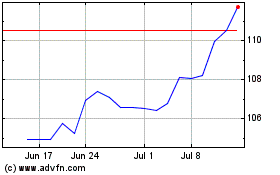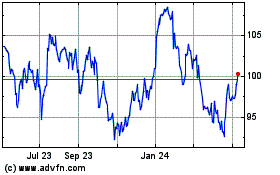At $2 Million, New Novartis Drug Is Priciest Ever
May 24 2019 - 5:28PM
Dow Jones News
By Denise Roland
The world's most expensive medicine is about to hit the
market.
A one-time treatment for a devastating infant muscle-wasting
disease won approval from the U.S. Food and Drug Administration
Friday. Its maker Novartis AG says the gene therapy will cost
$2.125 million.
The therapy, called Zolgensma, treats an inherited disease
called spinal muscular atrophy, or SMA, whose victims typically die
before the age of two if untreated. It is the latest gene therapy
-- a technique that introduces new DNA into the body to correct a
faulty gene -- to win approval.
Gene therapies promise the chance to cure diseases whose
diagnoses were death sentences, but the prices for the first few to
be greenlighted raise concerns about whether they can be afforded
by governments and health insurers that have been struggling to
control health spending.
Zolgensma's price tag makes it the world's most expensive
medicine by a large margin, with the next most expensive drug a
gene therapy called Luxturna that is priced at $850,000. However,
some drugs that are taken repeatedly would cost more over the
lifetime of a patient.
To allay concerns over the cost, Novartis said it would offer
insurers the option to pay for the treatment in equal, annual
installments over five years. The company also pledged to issue
partial refunds if the treatment doesn't work.
Novartis also defended the overall price by comparing it to a
treatment already on the market. David Lennon, head of Novartis's
AveXis unit that developed Zolgensma, said in a call with reporters
it would cost half that of the current standard treatment,
Spinraza, over a 10-year period.
Biogen Inc. priced Spinraza, which patients would have to take
for a lifetime, at $750,000 for the first year and then $375,000
for each year after that.
Dr. Lennon also pointed to a revised cost-effectiveness analysis
by the independent nonprofit Institute for Clinical and Economic
Review, which said the treatment could justify a price tag of up to
$2.1 million.
ICER had previously said Zolgensma should cost no more than $1.5
million, but updated its analysis after new clinical trial data
showed promising results in very young babies treated before the
symptoms of SMA set in.
Zolgensma "is highly cost effective and represents a product at
a fair and reasonable price," Dr. Lennon said.
Spinal muscular atrophy is the most common genetic cause of
death in infants, affecting 400 to 500 children born in the U.S.
each year, around 300 of whom have the most severe version that
kills by age 2. It lacked drug treatment until the FDA approved
Spinraza in 2016.
All 12 babies treated in Zolgensma's first clinical trial have
passed their second birthday, with most hitting key milestones like
holding up their heads, eating by mouth and sitting unaided,
according to the FDA's announcement. The therapy's long-term
effects aren't known yet.
"Today's approval marks another milestone in the
transformational power of gene and cell therapies to treat a wide
range of diseases," acting FDA Commissioner Ned Sharpless said in a
statement.
The prospect of more expensive gene and cell therapies hitting
the market concerns insurers. The FDA expects to approve 10 to 20
gene and cell therapies a year by 2025.
"The big plans can handle [Zolgensma] financially," said Steve
Miller, chief clinical officer at Cigna Corp. "They are more
worried about the precedent it sets than the impact on cash
flow."
Novartis had been trying to lay the groundwork for Zolgensma's
price tag by talking publicly about a multimillion-dollar figure
and playing up the therapy's effectiveness.
Michael Sherman, chief medical officer of health plan Harvard
Pilgrim Health Care, said Novartis's pricing was fair. "We're
comfortable that it's within the pricing we would deem
appropriate," Dr. Sherman said, pointing to the updated ICER
analysis.
He said Harvard Pilgrim is finalizing a deal with Novartis to
get some money back if Zolgensma proves ineffective.
Drugmakers' plans to offer such "value-based agreements" have
been stymied by the pricing rules of the U.S. federal government's
Medicaid health-insurance program, which place an upper limit of
around 17% on any rebate that drugmakers can offer for pediatric
drugs.
To get around the roadblock, Novartis will get paid in full
upfront by a middleman, the specialty pharmacy Accredo owned by
Cigna, which will then manage the installment payments.
Write to Denise Roland at Denise.Roland@wsj.com
(END) Dow Jones Newswires
May 24, 2019 17:13 ET (21:13 GMT)
Copyright (c) 2019 Dow Jones & Company, Inc.
Novartis (NYSE:NVS)
Historical Stock Chart
From Mar 2024 to Apr 2024

Novartis (NYSE:NVS)
Historical Stock Chart
From Apr 2023 to Apr 2024
